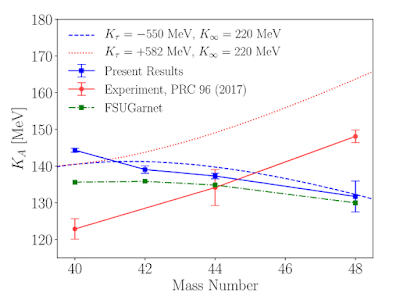Over the Christmas holidays, a paper appeared on the subject of giant monopole resonances in Calcium isotopes. The title of the paper is Compression-mode resonances in the calcium isotopes and implications for the asymmetry term in nuclear incompressibility (doi:10.1016/j.physletb.2019.135185), by Kevin Howard et al., based on experimental work that took place at RCNP Osaka.
Giant monopole resonances are a subclass of "compression-mode" resonance; excited nuclear states in which the nucleus is vibrating in a spherically-symmetric way, inflating and deflating like a balloon. A principal interest of these modes is that their properties tell us something about how much a nucleus likes being squashed. To a first approximation, they don't like it at all. Nuclei are (like liquids) really hard to compress. It's not impossible, though, and measuring just how hard they are to compress tells us something about the underlying nuclear forces via the equation of state of nuclear matter.
Motivating Howard et al.'s experiment is some recent published results from Texas A&M University (TAMU) in which the energy of the giant monopole resonances across calcium isotopes were found to increase as the mass number of the calcium isotope increased. Usually, one expects that as nuclei get heavier (and larger), the giant resonances occur at lower energy. One can think of the vibrations as having to have nodes at the surface of the nucleus, and the wavelength of the vibration gets longer in a heavier (larger) nucleus. Thanks to Planck's quantization rule, longer wavelength means lower energy. More specifically in this case, there is (also) expected to be a decrease in energy when one specifically is making the nucleus more asymmetric between protons and neutrons, as happens when going from the calcium-40 to calcium-48 -- the chain in question here.
Howard et al.'s work, then, was aimed at checking the surprising result. Their answer is in disagreement with the TAMU data, showing instead the normal order. The results are here in the figure from the paper (the whole thing is published open access via the link above). The decreasing solid blue line show the results from the Howard et al. work, while the increasing red solid line is the TAMU data. The other lines are models of various levels of sophistication. While the new data is reassuring, in that it agrees with our understanding of nuclear forces, either a third set of experiments, or a reevaluation of the TAMU data looks in order.
The year 2020 is the year of calcium-40; the nucleus with 20 protons and 20 neutrons :-)

No comments:
Post a Comment